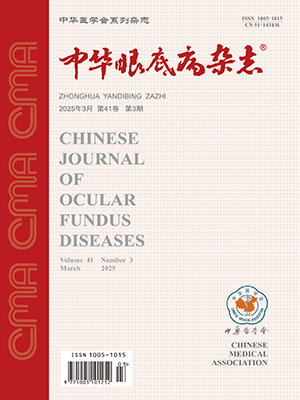Objective To observe the characteristics of indocyanine green angiography (ICGA) in inactive polypoidal lesions of polypoidal choroidal vasculopathy (PCV). Methods The clinical data of 36 PCV patients (37 eyes) with inactive polypoidal lesions were retrospectively analyzed. The follow-up of 11 eyes were ranged from nine to 29 months, with a mean of (12.3 plusmn;5.5) months. All the patients were examined for visual acuity, intraocular pressure, slit lamp microscope, fundus photography, fundus fluorescein angiography (FFA) and ICGA. According to the ICGA characteristics, PCV lesions were divided into active polypoidal lesions (pocket like hyperfluorescence at early stage and fluorescence leakage or stained with fluorescein at late stage) and inactive polypoidal lesions (pocket like hyperfluorescence and it was gradually faded). According to clinical and ICGA characteristics, inactive polypoidal lesions were divided into asymptomatic group, atrophic and/or cicatricial group and combined (with active polypoidal lesions) group. The visual acuity, fundus, lesions change and image characteristics of three groups were evaluated and analyzed. Results Among the 37 eyes, the time from indocyanine green (ICG) injection to inactive polypoidal lesions begin showing was ranged from 8.2 to 27.0 minutes, with a mean of (15.5 plusmn;4.8) minutes. There were five eyes (13.5%), eight eyes (21.6%) and 24 eyes (64.9%) in asymptomatic group, atrophic and/or cicatricial group and combined group, respectively. The results of fundus examination showed that there was no hemorrhage, exudates, retinal pigment epithelium detachment (PED) and/or neural retina detachment in asymptomatic group; atrophy lesions and/or scar lesions were observed in atrophic and/or cicatricial group and there was also no hemorrhage, exudate, PED and/or neural retina detachment; there was no atrophy lesion and/or scar lesion, but there were 10 eyes with subretinal hemorrhage, 15 eyes with retinal exudate, 10 eyes with PED and four eyes with neural retina detachment in combine group. The results of ICGA showed that there were inactive polypoidal lesions in asymptomatic group; inactive polypoidal lesions located at the border of atrophy lesions and/or scar lesions in atrophic and/or cicatricial group; active polypoidal lesions and inactive polypoidal lesions coexisted in combine group. In 11 eyes which completed the follow-up, inactive polypoidal lesions regressed in three eyes (27.3%), partial regressed in two eyes (18.2%), unchanged in six eyes (54.5%). Conclusions The inactive polypoidal lesions of PCV mainly appear in the middle or late stage of ICGA and are manifested in asymptomatic, atrophic and/or cicatricial and combined eyes. The combined type which coexisted with active polypoidal lesions is the main form.
Citation: 曾仁攀,文峰,张雄泽,李猛,左成果,罗光伟. Characteristics of indocyanine green angiography in inactive polypoidal lesions of polypoidal choroidal vasculopathy. Chinese Journal of Ocular Fundus Diseases, 2012, 28(5): 449-453. doi: Copy
Copyright © the editorial department of Chinese Journal of Ocular Fundus Diseases of West China Medical Publisher. All rights reserved




